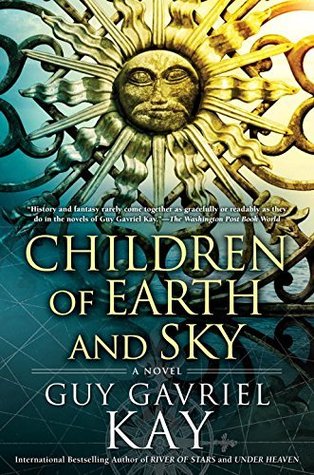Here's the Goodreads blurb on the book:
The bestselling author of the ground breaking novels Under Heaven and River of Stars, Guy Gavriel Kay is back with a new novel, Children of Earth and Sky, set in a world inspired by the conflicts and dramas of Renaissance Europe. Against this tumultuous backdrop the lives of men and women unfold on the borderlands—where empires and faiths collide. From the small coastal town of Senjan, notorious for its pirates, a young woman sets out to find vengeance for her lost family. That same spring, from the wealthy city-state of Seressa, famous for its canals and lagoon, come two very different people: a young artist traveling to the dangerous east to paint the grand khalif at his request—and possibly to do more—and a fiercely intelligent, angry woman, posing as a doctor’s wife, but sent by Seressa as a spy. The trading ship that carries them is commanded by the accomplished younger son of a merchant family, ambivalent about the life he’s been born to live. And farther east a boy trains to become a soldier in the elite infantry of the khalif—to win glory in the war everyone knows is coming. As these lives entwine, their fates—and those of many others—will hang in the balance, when the khalif sends out his massive army to take the great fortress that is the gateway to the western world...
Read on for my spoiler-free review.
Overall Impression
This was a great book. It combines an interesting historical period with some magic and strong character-driven stories. I was fascinated by the historical aspect and kept trying to guess or find out what the various nations and people were supposed to represent. Although I can't say I'm an expert of the late 1400s, I still was able to see the main historical players at the time and could research the rest. Of course, none of this is required to enjoy the story, but for me it was an added bonus.
Plot
Like many of Kay's books, the plot meanders through the life stories of the main characters. One of the central stories is the journey of Pero Villani to paint the Khalif in Asharias. His journey eventually links up all the main characters in their various stories and changes them irrevocably. Each character has their main arc, and they each progress at different paces throughout the book. I was pleasantly surprised as to how all the various character stories end- Kay follows characters all the way through their lives, some even unto (or beyond) their deaths.
Characters
There are many characters in this story that get moments with their point of view, but the central ones to the story are Danica, a Senjani raider; Marin Djivo, a merchant of Dubrava; Pero Villani, an artist from Seressa; Leonora Valeri, a noblewoman; and Damaz, a djanni soldier. Fate brings these various characters together and together they change the world without even realizing it. All these, and some of the minor one-off characters, are fascinating glimpses into this fantastical/historical world.
Setting / World Building
One of the selling aspects of this book is its take on a historical setting. The book itself is in a fantasy world, but everything about it screams at you that it's real, because it is based on how the world was in the late 1400s. The Osmanli are clear analogs to the Ottoman Empire, and their taking of Asharias (formerly Sarantium) is meant to represent the fall of Constantinople (to be renamed Istanbul). The Holy Jaddite Empire represents the Holy Roman Empire and Seressa represents the merchant republic of Venice. I had to look it up, but it appears Dubrava is an analog for Ragusa and the Senjani are the Uskoks of Croatia. Finally, some characters like Rasca Tripon (aka Skandir) sound to me like adaptations of real world figures like Skanderbeg.
In addition to the clash of the two main faiths, Jad and Ashar, there is mentions of a third one that's been pretty much wiped out. However, several characters appear linked to it and some of the more overt magic we see in the book is sometimes attributed to it. It's a powerful reminder that this is fantasy and not real history, even if it can reflect on superstitions and myths of the time.
Final Thoughts
This was an excellent book with strong characters that drive an interesting plot in a magical setting heavily based in history. I don't know if I would call it my favorite of Kay's work (I'm still a big fan of Tigana), but it certainly ranks pretty high up. I have not read any of his other works that deal with Sarantium, so it may be worthwhile for me to explore those further. If you liked Tigana, or any of Kay's other historical/fantasy books, you'll likely enjoy this one too.

No comments:
Post a Comment
Note: Only a member of this blog may post a comment.